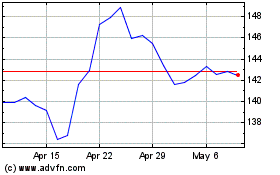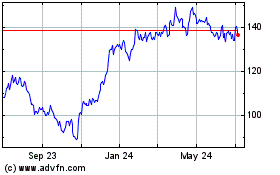Auto Lenders Have New Reason to Worry
October 26 2016 - 4:32PM
Dow Jones News
By AnnaMaria Andriotis
For auto lenders, there is trouble on the used-car lot.
Several large companies have warned that prices of used vehicles
are likely to weaken, potentially leading to higher losses on loans
on which cars are the collateral. That, combined with looser terms
for loans and the growth of loans going to subprime borrowers, is
sounding a warning for the long credit boom that has spurred auto
sales.
Auto-loan balances topped $1 trillion for the first time ever
this year. Actual default rates remain low, but losses are starting
to tick up, leading some big lenders to scale back. That has the
credit underpinnings of the auto boom looking shakier.
"Losses are going to go higher -- there's no question about
that," said Hylton Heard, senior director at Fitch Ratings.
Ally Financial Inc., the second-largest auto-loan lender by
volume behind Wells Fargo & Co., said Wednesday that it began
to see used-car values fall in the third quarter. The company wrote
off an annualized 1.37% of its outstanding loans in the quarter --
up from 1.01% a year earlier and its highest charge-off rate since
at least the end of 2012.
A big reason: "An increase in loss severity during the quarter,
particularly with lower recovery value on our repossessions," said
Christopher Halmy, Ally's chief financial officer.
On Tuesday, Capital One Financial Corp. said it boosted its
provisions against loan losses, citing growth in auto-loan
originations, expectations that chargeoffs would gradually rise and
declining used-vehicle values.
Some lenders appear to be responding to the growing signs of
weakness by tapping the brakes. Wells Fargo said earlier this month
that its new auto loans fell 2% in the third quarter from a year
earlier. That was its first decline for the period in at least half
a decade.
In the third quarter, J.P. Morgan Chase & Co. reduced the
number of 84-month auto loans it was making, finance chief Marianne
Lake said on the bank's earnings call.
Earlier this year, J.P. Morgan chief James Dimon warned about a
weakening auto market and the potential for used-car prices to
drop. Indeed, prices of used cars that are up to eight years old
are down 3.6% in 2016 through September versus the same period a
year earlier, according to the NADA Used Car Guide, a division of
J.D. Power.
"It is the first time since 2008 that prices have fallen by any
material amount," said Larry Dixon, director of market intelligence
at the NADA Used Car Guide. The firm is projecting prices will
finish the year down by an average of 4% compared with 2015.
One reason for the deterioration is more supply hitting the
market. The number of cars coming off of leases this year is
expected to hit 3.1 million, up 33% from a year earlier, Mr. Dixon
said. Leasing accounted for a record 31.4% of all new-vehicle sales
in the second quarter, up from 13.5% in the second quarter of 2009,
according to Experian Automotive.
Leases typically run two to three years. With more cars being
leased, more cars are turned in and offered for sale.
An additional worry is that the latest surge in lending has been
driven in part by more subprime lending and easier credit terms.
New subprime auto loans in 2015 totaled $109.5 billion, up some 11%
from the prior year and up roughly 124% from 2010, according to
Equifax.
Annualized net losses for subprime securitized loans hit 8.9% in
August, up from 7% a year earlier and 5.9% the year before that,
according to Fitch.
Lenders have been loosening standards to keep loan volume
growing. That raises the prospect of more defaults.
One example is that loans with repayment periods of 73 to 84
months accounted for just over 31% of all new cars that were
financed in both the first and second quarter, a new high,
according to Experian. The risk is that when borrowers default,
their loan is worth more than the value of the car, which
depreciates rapidly. In that case, the loss gets transferred to the
lender.
All of this adds up to lower recovery rates for auto loans. The
so-called recovery rate for auto loans -- or the share of balances
in a default status that lenders are able to recover -- has dropped
in recent months, according to investment firm Jefferies LLC.
Auto lenders recovered 54.3% of outstanding loan balances that
were in default, bankruptcy, or charge-off status in September on
average, down from 56.4% a year prior. Industrywide, there were
year-over-year declines in recovery rates for eight out of the
first nine months of the year.
(END) Dow Jones Newswires
October 26, 2016 16:17 ET (20:17 GMT)
Copyright (c) 2016 Dow Jones & Company, Inc.
Capital One Financial (NYSE:COF)
Historical Stock Chart
From Mar 2024 to Apr 2024

Capital One Financial (NYSE:COF)
Historical Stock Chart
From Apr 2023 to Apr 2024
